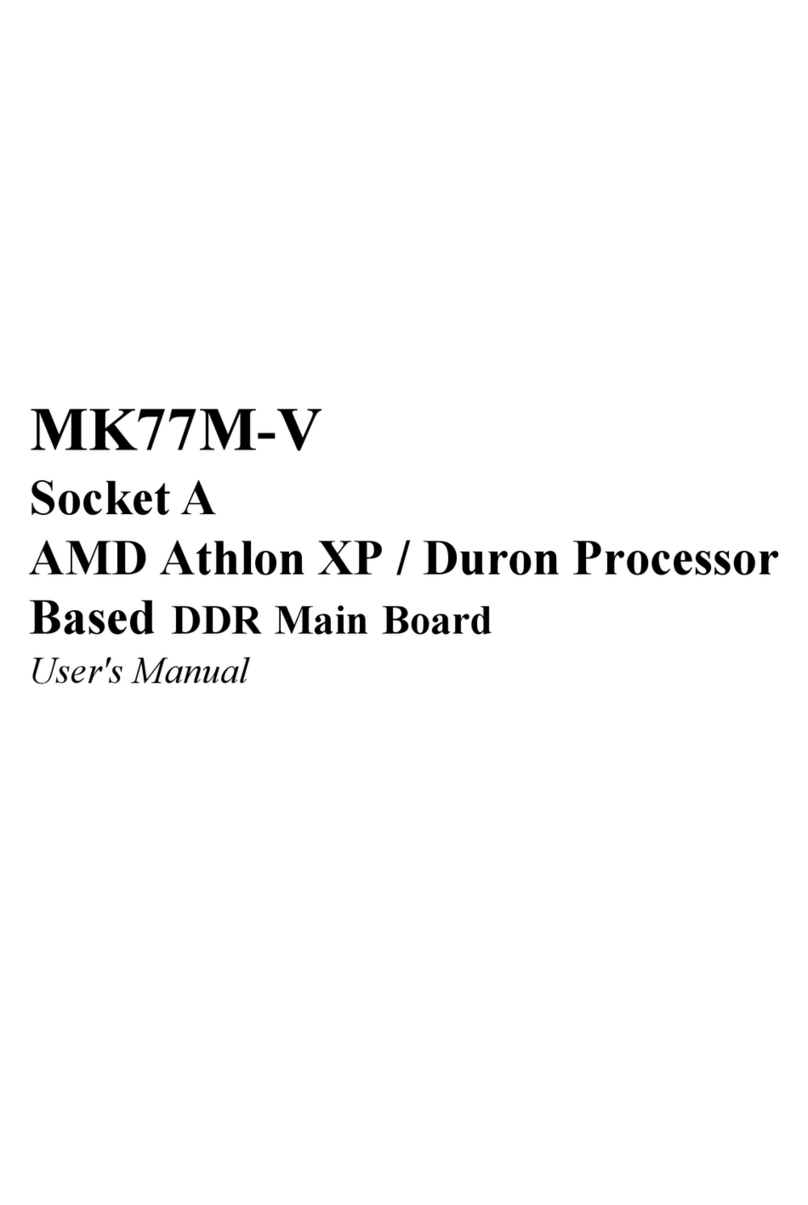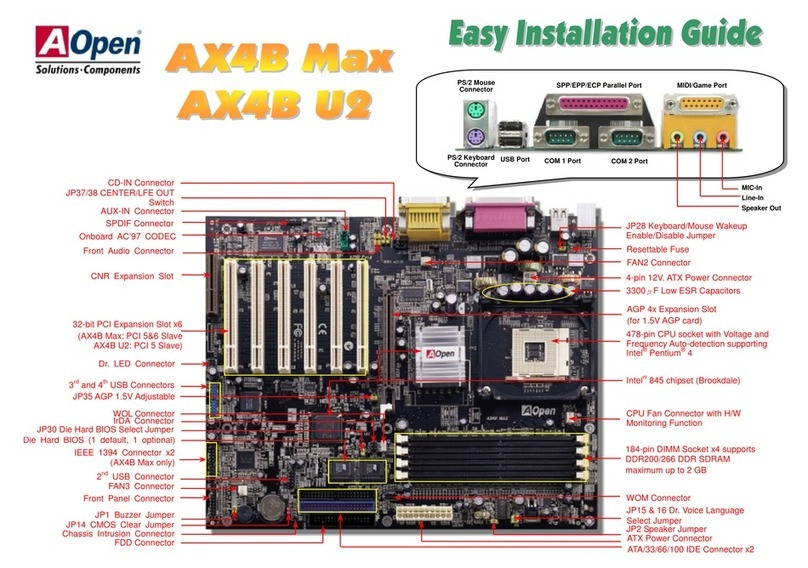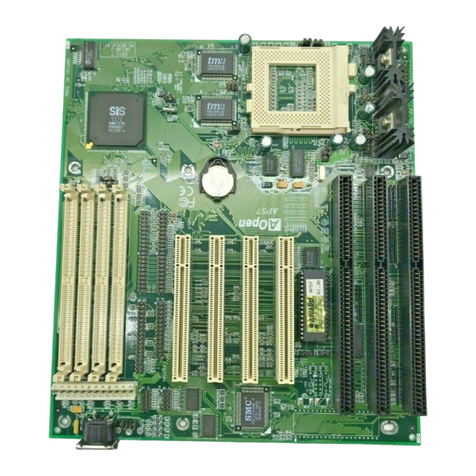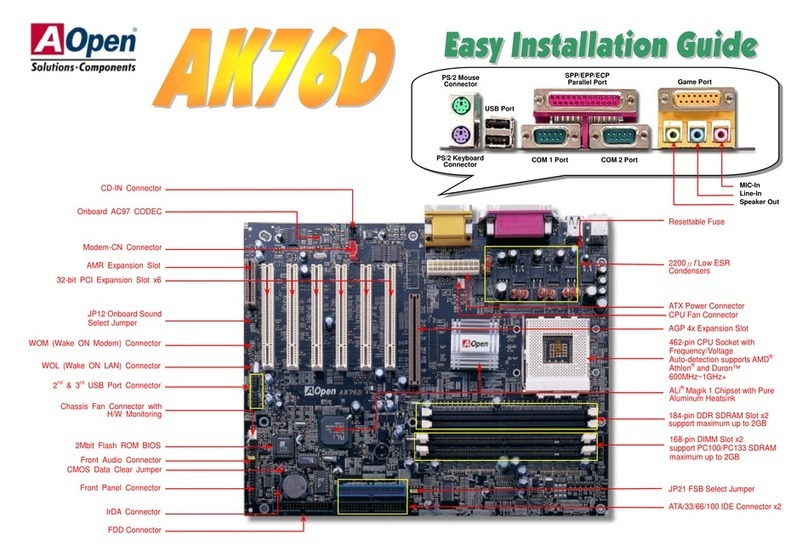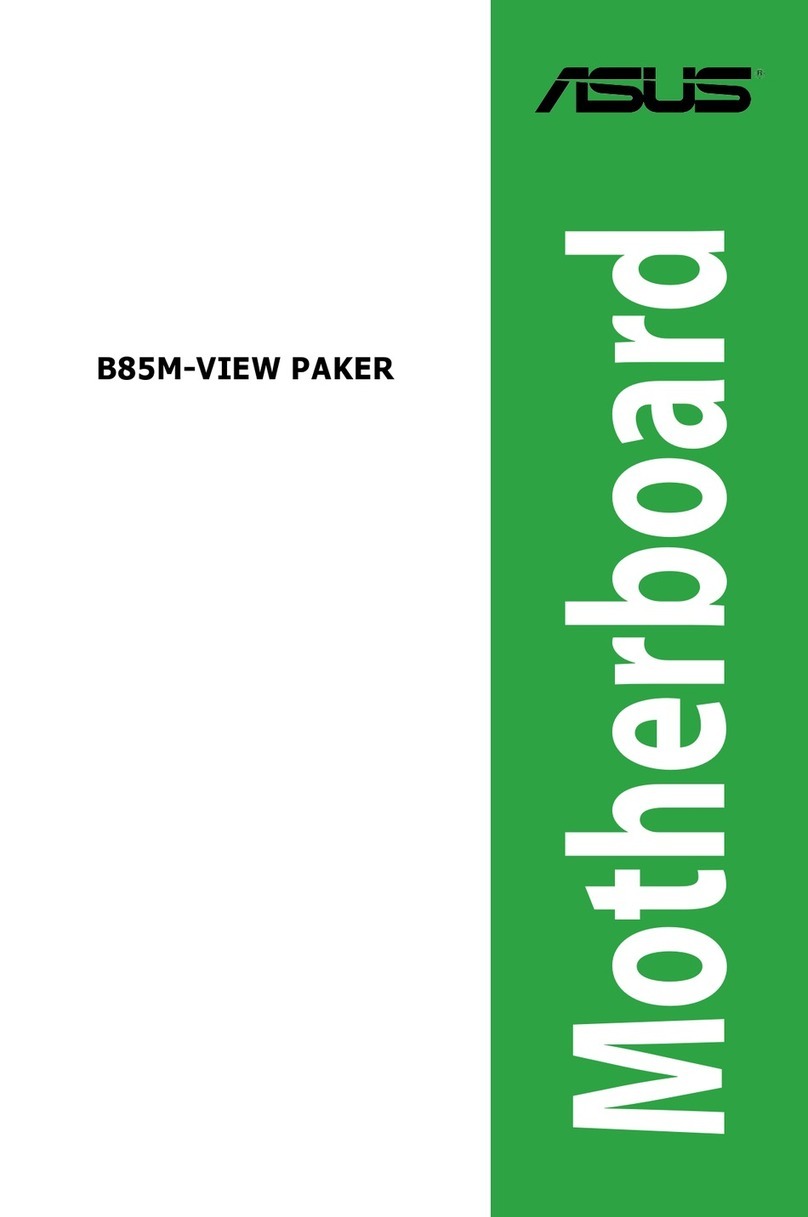AOpen AK86-L Datasheet

Resetable Fuse
ATX Power Connector
SYSFAN1 Connector
AGP 8X Expansion Slot
754-pin CPU Socket with Voltage and
Frequency Auto-Detection that supports
AMDTMAthlonTM 64 CPU
VIA
®
K8T800 Chipset and VT8237 SB
CPUFAN Connector
184-pin DIMMx3 supports DDR400 max. to
2GB and DDR333/266 max. to 3GB
STBY LED
CD-IN Connector
Onboard AC97 CODEC
AUX-IN Connector
Realtek Gigabit LAN Chip (for AK86-L)
32-bit PCI Ex
p
ansion Slot x5
Serial ATA Connecto
r
x2 (with RAID function)
VIA 10/100Mbps LAN Chip (for AK86-N)
COM2 Connector
IrDA Connector
SYSFAN2 Connector
Front Audio Connector
Front Panel Connector
JP14 CMOS Data Clear Jum
p
e
r
Case Open Connector
USB2.0 Connector x2
S/PDIF Connector
4-pin 12V.ATX Power Connector
3300μF Low ESR Capacitors
JP28 Keyboard/Mouse Wakeup Jumpe
r
PS/2 Mouse
Connector
PS/2 Keyboard
Connector USB2.0 Ports
SPP/EPP/ECP
Parallel Port
COM 1 Port
RJ45 LAN Jack Line-In
Speaker
Out
MIC-In
USB2.0 Ports
Phoenix Award 4Mbit Flash ROM BIOS
Game Port Connecto
r
IDE Connector x2 (ATA/66/100/133 supported)
AOpen reserves the right to revise all the specifications and information contained in this documentation, which are subject to change without notice.
FDD Connector

1. JP14 Clear CMOS
Everything you need to boot this
motherboard is included in this
Easy Installation Guide. For more
information, a complete Online
User's Manual can be found in the
Bonus Pack CD. Thanks for the
help of saving our earth.
PART NO: 49.8AD11.E01 DOC. NO: AK86L-EG-E0309B
This Easy Installation Guide x 1
User’s Manual x1
EzRestore Guide x 1
80-Wire IDE Cable x 1
Floppy Drive Cable x 1
Serial ATA Cable x 1
Serial ATA Power Cable x 1
Bonus Pack CD x 1
I/O Shield x 1
Norton Anti-Virus CD x 1
VIA VT8237 Serial ATA Driver Disk x 1
You can clear CMOS to restore system default setting. To
clear the CMOS, follow the procedure below.
1. Turn off the system and unplug the AC power.
2. Remove ATX power cable from connector PWR2.
3. Locate JP14 and short pins 2-3 for a few seconds.
4. Return JP14 to its normal setting by shorting pin 1 & pin 2.
5. Connect ATX power cable back to connector PWR2.
Tip: When should I Clear CMOS?
1. Boot fail because of overclocking…
2. Forget password…
3. Troubleshooting…
Pin 1
2. JP28 Keyboard/Mouse Wake-up Enable/Disable Jumper
This motherboard provides keyboard / mouse wake-up function. You can use JP28 to enable or disable this
function, which could resume your system from suspend mode with keyboard or mouse installed. The
factory default setting is set to “Disable” (1-2), and you may enable this function by setting the jumper to 2-3.
Pin 1
1
Disable
(Default)
1
Enable
1
Normal
(
default
)
1
Clear CMOS

Plug in the CPU fan cable to the 3-pin CPUFAN connector. If you have chassis fan, you
can also plug it on SYSFAN1 or SYSFAN2 connector.
5. Setting CPU Voltage & Frequency
3. Installing CPU & Housing Fan
Note: Some CPU fans do not have
sensor pin, so that cannot support
fan monitorin
g
.
CPUFAN Connector
SYSFAN2 Connector
Setting CPU Core Voltage
This motherboard supports CPU VID function. The CPU core voltage will be
automatically detected and the range is from 0.8V to 1.55V. It is not
necessary to set CPU Core Voltage
Setting CPU Frequency
This motherboard is CPU jumper-less design, you can set CPU frequency
through the BIOS setup, and no jumpers or switches are needed.
BIOS Setup > Frequency / Voltage Control > CPU Speed Setup
Core Frequency = CPU Clock * CPU Ratio
CPU Ratio From 8x to 50x step 1x
CPU Clock (By manual
Adjustment) 200~255 by 1MHz stepping adjustment technology
CPU CPU Core
Frequency CPU Clock Ratio
Athlon 64 3000+ 1.6GHz 200MHz 8x
Athlon 64 3200+ 1.8GHz 200MHz 9x
Athlon 64 3400+ 2.0GHz 200MHz 10x
Athlon 64 3700+ 2.2GHz 200MHz 11x
Athlon 64 4000+ 2.4GHz 200MHz 12x
Note: With CPU speed changing rapidly, there might be fastest CPU on the
market by the time you received this installation guide. This table is kindly for
your references only.
SYSFAN1 Connector
4. Connecting ATX Power Connector
This motherboard comes with a 20-pin and 4-pin ATX power connector. Make sure you plug
in the right direction. Warning: VIA®K8T800 chipset supports 200MHz system clock and 66MHz AGP
clock, higher clock setting may cause serious system damage.
Tip: If your system hangs or fails to boot because of overclocking, simply use <Home>
key to restore the default setting or you can wait the AOpen “Watch Dog ABS” reset
the s
y
stem in five seconds and s
y
stem will auto
-
detect hardware a
g
ain.
Warning: Supposed you have had adjusted CPU ratio on your current CPU, and you
plan to replace a new CPU. Please use <Home> key or Clear CMOS to restore the
default setting when changing a new CPU, because the system will still implement the
p
revious CPU settin
g
on the new one.
GND
+12V
SENSOR
GND
+12V
SENSOR
GND
+12V
SENSOR

8. Connecting Front Panel Cable
Attach the power LED, speaker, and reset switch connectors
to the corresponding pins. If you enable “Suspend Mode”
item in BIOS Setup, the ACPI & Power LED will keep
flashing while the system is in suspend mode.
Locate the power switch cable from your ATX housing. It is
2-pin female connector from the housing front panel. Plug
this connector to the soft-power switch connector marked
SPWR.
7. Connecting IDE, Floppy Cables
Pin 1 ATA 66/100/133
IDE Connector
FDD Connector
Connect 34-pin floppy cable and 40-pin IDE cable to floppy connector FDD connector. Be
careful of the pin1 orientation. Wrong orientation may cause system damage.
IDE 2 (Secondary)
IDE 1 (Primary)
Pin 1
6. Installing Memory Modules
ATA 66/100/133
1
SPEAKER
IDE LED
Power Switch
ACPI & Power LED
RESET
SPWR
GND
ACPILED-
GND
ACPILED+
NC
NC
GND
RESET
GND
NC
NC
+5V
IDE LED
IDE LED
+5V
+5V
GND
NC
SPEAKER
1
This motherboard has three 184-pin DDR DIMM sockets that allow you to install
DDR266/333 memory up to 3 GB and DDR400 memory up to 2GB. Non-ECC DDR RAM is
supported. Otherwise, it will cause serious damage on memory sockets or RAM module.
Please follow the table below to install RAM modules. Newly implemented function, the
Voltage of memory on this motherboard is adjustable from 2.5V to 2.7V for over clocking
purpose. DIMM 1
DIMM 2
DIMM 3
Number
of DIMMs DIMM 1 DIMM 2 DIMM 3 Max Speed
1 X8 or X16 single bank empty empty DDR400
1 empty X8 or X16 single bank empty DDR400
1 empty empty X8 or X16 single bank DDR400
1 X8 double bank empty empty DDR400
1 empty X8 double bank empty DDR400
1 empty empty X8 double bank DDR400
2 X8 or X16 single bank X8 or X16 single bank empty DDR400
2 X8 or X16 single bank X8 double bank empty DDR400
2 X8 or X16 single bank empty X8 or X16 single bank DDR400
2 X8 or X16 single bank empty X8 double bank DDR400
2 X8 double bank X8 or X16 single bank empty DDR400
2 X8 double bank X8 double bank empty DDR400
2 X8 double bank empty X8 or X16 single bank DDR400
2 empty X8 or X16 single bank X8 or X16 single bank DDR333
2 empty X8 or X16 single bank X8 double bank DDR266
2 empty X8 double bank X8 or X16 single bank DDR266
2 empty X8 double bank X8 double bank DDR266
2 X8 double bank empty X8 double bank DDR400
3 X8 or X16 single bank X8 or X16 single bank X8 or X16 single bank DDR333
3 X8 or X16 single bank X8 or X16 single bank X8 double bank DDR266
3 X8 or X16 single bank X8 double bank X8 or X16 single bank DDR266
3 X8 or X16 single bank X8 double bank X8 double bank DDR266
3 X8 double bank X8 or X16 single bank X8 or X16 single bank DDR333
3 X8 double bank X8 or X16 single bank X8 double bank DDR266
3 X8 double bank X8 double bank X8 or X16 single bank DDR266
3 X8 double bank X8 double bank X8 double bank DDR266
Tip: “X8” means that each chip on the module
bank is 8 bits, and “X16” means each chip is 16
bits. We know that each memory bank is 64 bits.
Therefore, if a memory module has 8 chips on
each bank it is “X8”, and if there are 4 chips on
each bank, it is “X16”.
Note: Due to the limitation of memory controller in the Athlon 64 CPU,
we do not recommend you to install three DDR333/266 modules.

Pi
n
1
10. Support Eight USB 2.0 Ports
9. Front Audio Connector
If the housing has been designed with an audio port on the front panel, you’ll be able to
connect onboard audio to front panel through this connector. By the way, please remove
5-6 and 9-10 jumper caps from the Front Audio Connector before connecting the cable.
Please do not remove these 5-6 and 9-10 yellow jumper caps if there’s no audio port on
the front panel.
This motherboard provides eight USB ports to connect USB devices, such as mouse,
keyboard, modem, printer, etc. There are four connectors on the PC99 back panel. You
can use proper cables to connect the other two USB connectors to the USB modules or
front panel of chassis. Compared to traditional USB 1.0/1.1 with the speed of 12Mbps, USB
2.0 has a fancy speed up to 480Mbps, which is 40 times faster than the traditional one.
Pin 1
12. Super 5.1 Channel Audio Effect
This motherboard comes with an ALC655 CODEC, which supports high quality of 5.1
Channel audio effects, bringing you a brand new audio experience. On the strength of the
innovative design of ALC655, you're able to use standard line-jacks for surround audio
output without connecting any external module. To apply this function, you have to install
the audio driver in the Bonus Pack CD as well as an audio application supporting 5.1
Channel. Picture bellow represents the standard location of all speakers in 5.1 Channels
sound track. Please connect the plug of your front speakers to the green “Speaker out”
port, rear speakers’ plug to the blue “Line in” port and both of the center and subwoofer
speakers to the red “MIC in” port.
11. S/PDIF Connector
S/PDIF (Sony/Philips Digital Interface) is a newest audio transfer file format, which provides
impressive audio quality through optical fiber and allows you to enjoy digital audio instead of
analog audio. Through a specific audio cable, you can connect the S/PDIF connector to other
end of the S/PDIF audio module, which bears S/PDIF digital output. Normally there are two
S/PDIF outputs as shown, one for RCA connector, the most common one used for consumer
audio products, and the other for optical connector with better audio quality. Same as outputs,
you can also connect RCA or optical audio products to input connectors on the module and
have the voice or music come out from your computer. However, you must have a S/PDIF
supported speaker/amplifier/decoder with S/PDIF digital input/output to connect to the S/PDIF
digital input/output to make the most out of this function.
S/PDIF
Connecto
r
+5V
NC
S/PDIFOUT
GND
S/PDIFIN
1
S/PDIF Module
(User Upgrade Optional)
S/PDIF
Cable
S/PDIF OUT
S/PDIF IN
(RCA)
S/PDIF IN
(Optical)
S/PDIF O
UT
Pin 1
1 AUD_GND
AUD_VCC
AUD_RET_R
KEY
AUD_RET_L
AUD_MIC
AUD_MIC_BIAS
AUD_FPOUT_R
NC
AUD_FPOUT_L
Pi
n
1
NC
GND
SBD3+
SBD3-
+5V
KEY
GND
SBD2+
SBD2-
+5V
USB2 Connector
1
Other manuals for AK86-L
1
This manual suits for next models
1
Table of contents
Other AOpen Motherboard manuals

AOpen
AOpen AX4SGnWLAN User manual
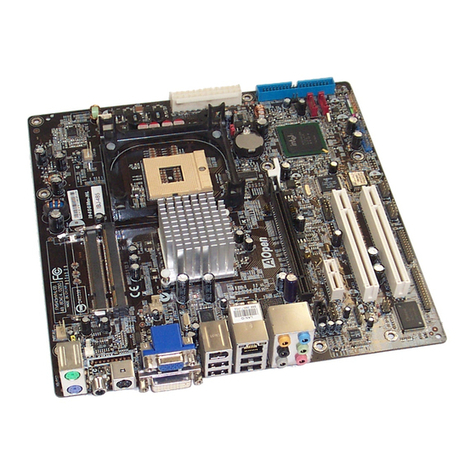
AOpen
AOpen i945GTm-VHL User manual

AOpen
AOpen AX4T II-133 Setup guide

AOpen
AOpen Fortress 7000 User manual

AOpen
AOpen Manual User manual
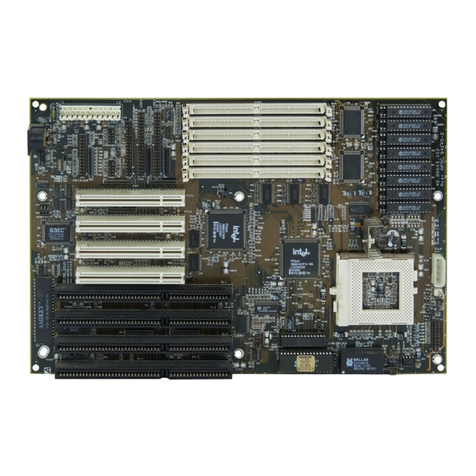
AOpen
AOpen AP5C User manual

AOpen
AOpen AX45-533 Max Datasheet

AOpen
AOpen AX34 Pro II User manual
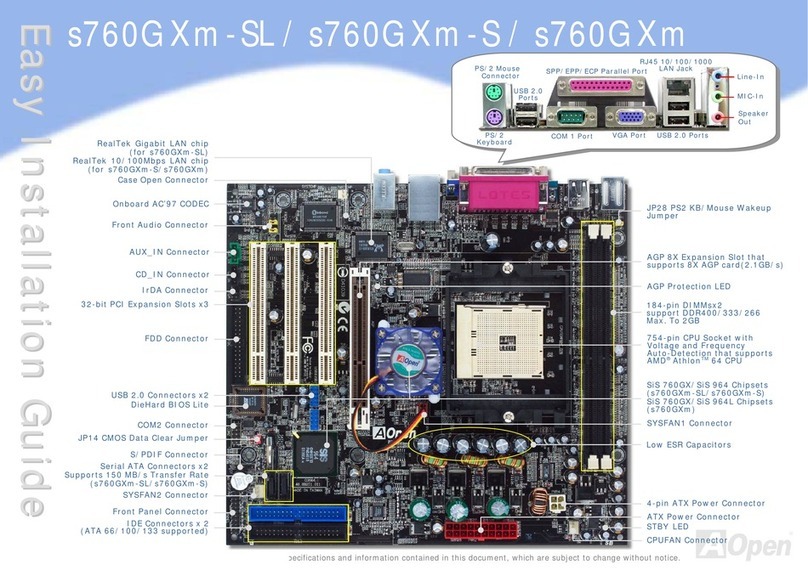
AOpen
AOpen s760GXm-SL Datasheet

AOpen
AOpen AX4G Setup guide

AOpen
AOpen AX45H-8X Max Setup guide
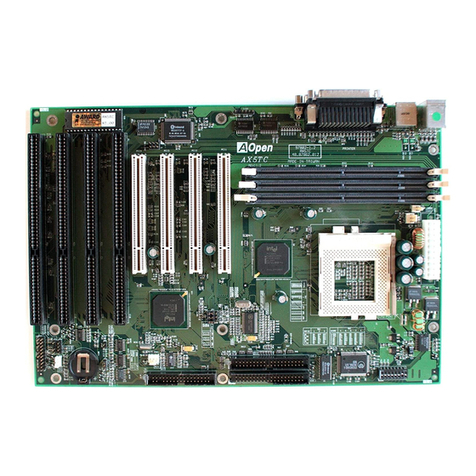
AOpen
AOpen AX5TC User manual
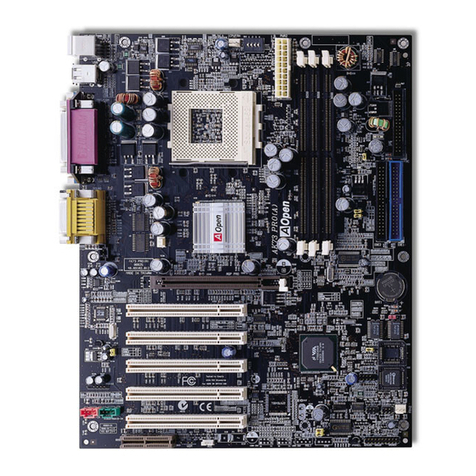
AOpen
AOpen AK73(A)-V Datasheet
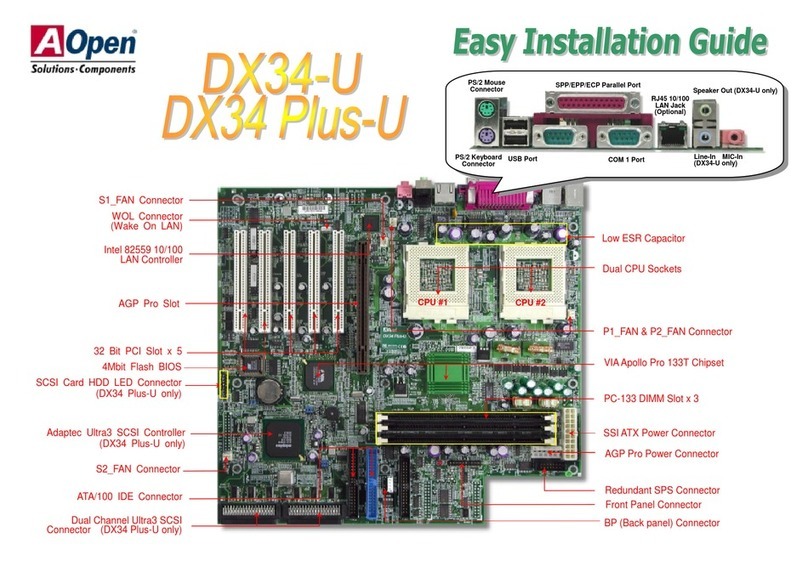
AOpen
AOpen DX34-U User manual

AOpen
AOpen i865PEa-7ILFR User manual

AOpen
AOpen MX4L Setup guide

AOpen
AOpen AX6LC User manual

AOpen
AOpen AX4C Max II Setup guide

AOpen
AOpen MX3W-E3 Setup guide
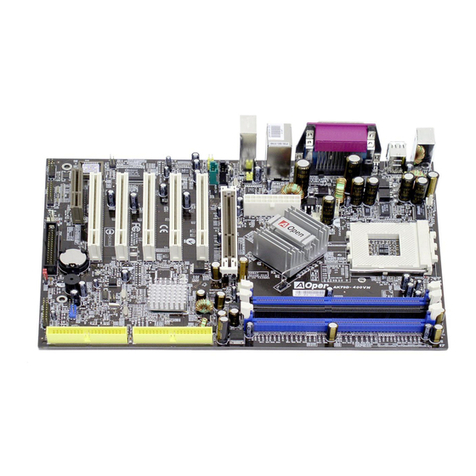
AOpen
AOpen AK79D-400VN Setup guide
